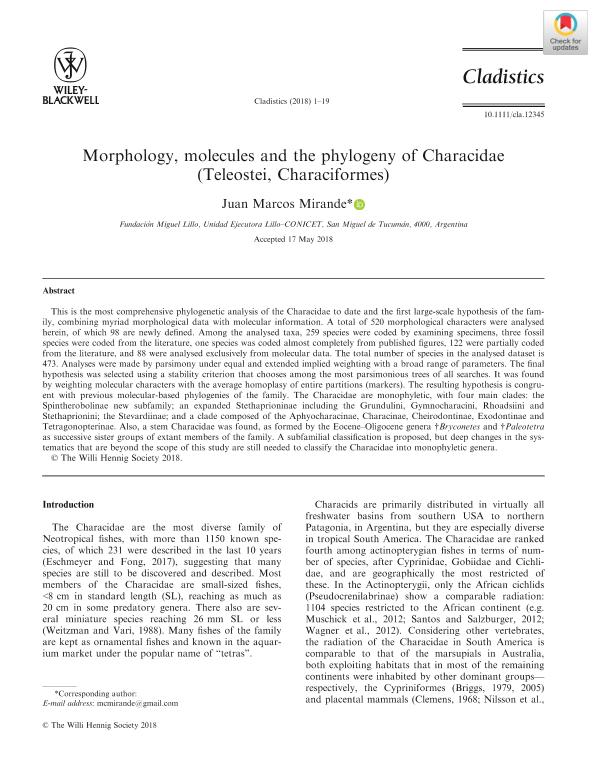Mostrar el registro sencillo del ítem
dc.contributor.author
Mirande, Juan Marcos

dc.date.available
2019-10-18T14:24:16Z
dc.date.issued
2018-06
dc.identifier.citation
Mirande, Juan Marcos; Morphology, molecules and the phylogeny of Characidae (Teleostei, Characiformes); Wiley Blackwell Publishing, Inc; Cladistics; 35; 3; 6-2018; 282-300
dc.identifier.issn
0748-3007
dc.identifier.uri
http://hdl.handle.net/11336/86318
dc.description.abstract
This is the most comprehensive phylogenetic analysis of the Characidae to date and the first large‐scale hypothesis of the family, combining myriad morphological data with molecular information. A total of 520 morphological characters were analysed herein, of which 98 are newly defined. Among the analysed taxa, 259 species were coded by examining specimens, three fossil species were coded from the literature, one species was coded almost completely from published figures, 122 were partially coded from the literature, and 88 were analysed exclusively from molecular data. The total number of species in the analysed dataset is 473. Analyses were made by parsimony under equal and extended implied weighting with a broad range of parameters. The final hypothesis was selected using a stability criterion that chooses among the most parsimonious trees of all searches. It was found by weighting molecular characters with the average homoplasy of entire partitions (markers). The resulting hypothesis is congruent with previous molecular‐based phylogenies of the family. The Characidae are monophyletic, with four main clades: the Spintherobolinae new subfamily; an expanded Stethaprioninae including the Grundulini, Gymnocharacini, Rhoadsiini and Stethaprionini; the Stevardiinae; and a clade composed of the Aphyocharacinae, Characinae, Cheirodontinae, Exodontinae and Tetragonopterinae. Also, a stem Characidae was found, as formed by the Eocene–Oligocene genera †Bryconetes and †Paleotetra as successive sister groups of extant members of the family. A subfamilial classification is proposed, but deep changes in the systematics that are beyond the scope of this study are still needed to classify the Characidae into monophyletic genera.
dc.format
application/pdf
dc.language.iso
eng
dc.publisher
Wiley Blackwell Publishing, Inc

dc.rights
info:eu-repo/semantics/openAccess
dc.rights.uri
https://creativecommons.org/licenses/by-nc-sa/2.5/ar/
dc.subject
ICHTHYOLOGY
dc.subject
CLADISTICS
dc.subject
OSTARIOPHYSI
dc.subject
PARSIMONY
dc.subject.classification
Zoología, Ornitología, Entomología, Etología

dc.subject.classification
Ciencias Biológicas

dc.subject.classification
CIENCIAS NATURALES Y EXACTAS

dc.title
Morphology, molecules and the phylogeny of Characidae (Teleostei, Characiformes)
dc.type
info:eu-repo/semantics/article
dc.type
info:ar-repo/semantics/artículo
dc.type
info:eu-repo/semantics/publishedVersion
dc.date.updated
2019-10-16T19:13:58Z
dc.journal.volume
35
dc.journal.number
3
dc.journal.pagination
282-300
dc.journal.pais
Reino Unido

dc.description.fil
Fil: Mirande, Juan Marcos. Consejo Nacional de Investigaciones Científicas y Técnicas. Centro Científico Tecnológico - Tucumán. Unidad Ejecutora Lillo; Argentina
dc.journal.title
Cladistics

dc.relation.alternativeid
info:eu-repo/semantics/altIdentifier/url/https://onlinelibrary.wiley.com/doi/abs/10.1111/cla.12345
dc.relation.alternativeid
info:eu-repo/semantics/altIdentifier/doi/https://dx.doi.org/10.1111/cla.12345
Archivos asociados
